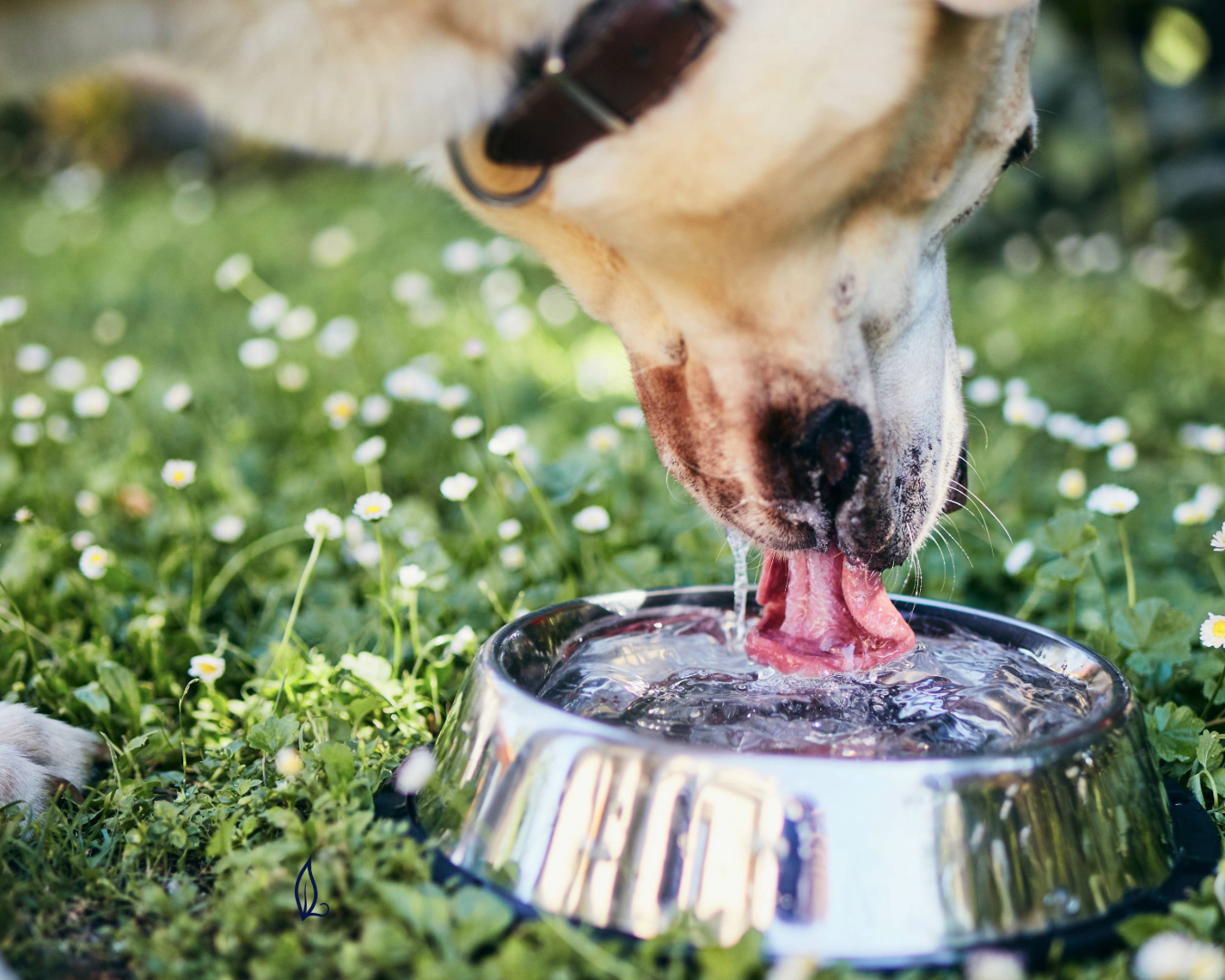The type of drinking water we give to our pets has become a controversial topic that many people feel passionate about. At the same time, pet parents may not have given any thought to the safety of their pet’s drinking water. Everything we and our furry companions consume has the potential to help or harm. It is essential to be as informed as possible to make the best decisions we can for our pets - even for something as basic as drinking water.
Is tap water safe enough for my pet to drink?
The short answer to this question is…probably not. Unfortunately, water distribution systems in most U.S. cities and municipalities provide water containing toxins and pollutants. A veterinary study published in 2022 concluded that pollutants in tap water increase the risk of certain cancers in dogs. Researchers found dogs with bladder cancer were more likely to live in areas with higher tap water concentrations of total trihalomethane. Trihalomethane is a reactive byproduct of disinfection chemicals, especially chlorination, which are often used in municipal tap water.
More than 320 toxins have been detected in U.S. tap water, according to an analysis by the Environmental Working Group (EWG). Some of these toxins include:
-
PFAS (“forever chemicals”) accumulate in the body and do not break down in the
environment, have been linked to cancer, immune suppression, fetal harm and reduced vaccine effectiveness. - Disinfection by-products like chlorine disinfectants used to treat water can form harmful byproducts linked to cancer and reproductive health issues.
- Heavy metals like arsenic are naturally occurring minerals that can cause bladder, lung and skin cancer as well as harm to the skin and lungs.
-
Chromium-6 is a carcinogen that is usually produced by industrial processes but can
occur naturally. It has been detected in groundwater because of these industries’
pollution, and from natural gas compression stations that use it as an anti-corrosion agent in cooling water. - Nitrates from farm runoff and wastewater can contaminate drinking water, especially in rural areas.
- Volatile organic compounds (VOCs) like trichloroethylene or TCE, perchloroethylene and benzene are widespread contaminants linked to industrial pollution and environmental persistence (chemicals that resist environmental degradation over time). These chemicals, even at low concentrations, can cause cancer, liver damage and neurological issues.
- Radiological contaminants like radium and uranium have been detected in many water systems, sometimes exceeding EPA limits. Long-term exposure can lead to neurological disorders, developmental delays and organ damage.
If your water is sourced from a well, please note that the same or similar contaminants may be found. Even if your well water smells, tastes, and appears normal, that doesn’t necessarily mean it’s safe. Many pollutants are totally undetectable by our senses, including some of the biggest hazards to our health. Lead, E. coli, and arsenic, for example, are dangerous contaminants that can lurk in clear, normal smelling and tasting well water.
How can I test the safety of my drinking water?
The EWG Tap Water Database allows you to check the water quality in your area. Simply enter your ZIP code to see a detailed report on your local water supply and any potential contaminants present. Another option is to research the quality of your water by accessing your community’s Annual Quality Report. Check the NRDC (Natural Resources Defense Council) report “What’s On Tap?”, and ask your water utility (the company that bills you monthly) for a copy of its annual water quality report. This report will list the detected contaminants, the potential source(s) of those contaminants, and the levels at which those contaminants were present in the water supply.
Unlike utility or “city” water, which is upheld by the monitoring and treatment infrastructure of water utilities, well water is not regulated. Consequently, well water quality is the responsibility of the homeowner. Testing your well water with a laboratory is the only way to ensure you know exactly what’s in your drinking water.
Should tap water be filtered before giving it to my pet?
Given that tap water likely contains harmful substances like toxins and carcinogens, a water filter would be a smart investment for the entire household. There are many different types of filters available on the market. Some filters excel at removing certain contaminants but struggle with others, making it essential to choose the right one based on the specific contaminants in your water supply. Factors such as filter longevity, cost, and ease of use also play a role in selecting the best option for your specific situation. While filtering tap or well water could decrease the overall incidence of cancer, there are benefits and drawbacks to each type. The most common types of filters are:
- Countertop Filter: A countertop filter is likely going to be the most economical. However, the Environmental Working Group tested 10 different countertop water filter brands and found that their effectiveness varied significantly. To see which filters perform best and find one suited to your water quality, check out EWG’s guide.
- Reverse Osmosis Filter: Reverse Osmosis (RO) filters use pressure to force water through a semipermeable membrane to produce a treated stream of water and a stream of rejected water. According to the US Environmental Protection Agency, RO systems “can potentially remove water contaminants such as lead, volatile organic compounds (VOCs), PFAS, arsenic, bacteria, and viruses.” These systems can generate a significant amount of waste water so they may not be the most ecologically friendly option. Look for systems that create minimal waste water during treatment.
There has been some controversy over whether RO water is a good option for pets. Rita Hogan, a canine herbalist, warns that you should replace the minerals if you are using RO water for your pets because it can lead to kidney issues over time due to lack of minerals. Dr. Peter Dobias agrees saying “Unfortunately, reverse osmosis removes minerals (in addition to harmful contaminants) which leads to mineral depletion.” If you are looking at purchasing an RO system, be sure to buy one that reintroduces minerals back into the water before distribution.
Why is bottled, distilled or alkaline drinking water not the best option?
Many people believe bottled, distilled, and alkaline water are good options for drinking water. However, there are drawbacks to each. For example, this review article shows that water (even spring water) in plastic bottles contains endocrine disrupting chemicals and microplastics. In her book The Herbal Dog, Rita Hogan suggests that even a simple countertop filter is better than tap or bottled water.
Distilled water has a reputation for being the cleanest water. Distillation systems boil water and then collect the water as it cools. According to the Center for Disease Control (CDC), “The chemical distillation process will remove arsenic, barium, cadmium, chromium, lead, nitrate, sodium, sulfate, calcium, magnesium, and many organic (carbon-containing) chemicals.” However, “distillation does not remove some volatile (evaporate easily) organic compounds, volatile solvents, and certain pesticides.” Furthermore, like water filtered with reverse osmosis, distilled water is void of natural minerals. Dr. Peter Dobias warns that drinking distilled water results in the body losing cellular minerals and reduces the electrolyte balance.” According to a World Health Organization report, demineralized water needs to be fortified with minerals to avoid serious health concerns. Dr. Karen Becker agrees and says, “I like to use distilled water with pets as a means of periodic detoxification. What I have seen longer term, though, is it seems to have a profound mineral leaching effect that could be detrimental over time. Many animals are already mineral deficient, and I’ve seen some negative consequences with animals’ ability to replenish their minerals when they're on distilled water longer than let's say, a year.”
Alkaline water has a pH above 7.0. It has become a topic of debate in human health, claiming numerous health benefits, so naturally people think that pets can experience the same benefits. The pH of drinking water can impact the urine pH of our pets. The optimal urine pH is critical for the prevention of crystals and stones. Struvite crystals will form in urine with a high pH (generally above 7.5). If your pet is eating an optimal, high-moisture, species-appropriate diet and still makes abundant crystals, you might want to test your water. The pH of water can be tested using pH test strips. When it comes to dogs, the optimum pH of canine blood is slightly acidic, and the ideal urine pH should be around 6 - 6.5.
The water that pets and their parents drink has the potential to be contaminated with numerous toxins including “forever chemicals” and other carcinogens. Giving your pet filtered water is an easy way to decrease their exposure to these toxins and chemicals and potentially increase their lifespan. The amount of information available on this subject can be overwhelming. It’s worth exploring the different types of water available to us as more research comes to light on this topic. Choose the filter technology that best suits your circumstances and budget, and that addresses the contaminants in your area. There is no best option applicable to all pets since each type of filter has its strengths and limitations, and one type does not accomplish all goals.
Disclaimer: This content is for informational purposes only and is not meant to diagnose, treat, or replace consulting a primary veterinarian for individualized care.

